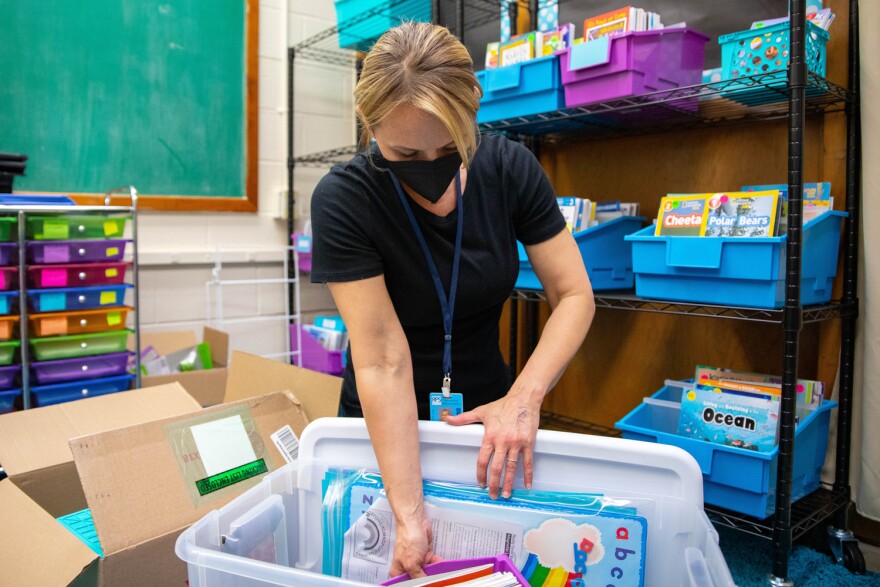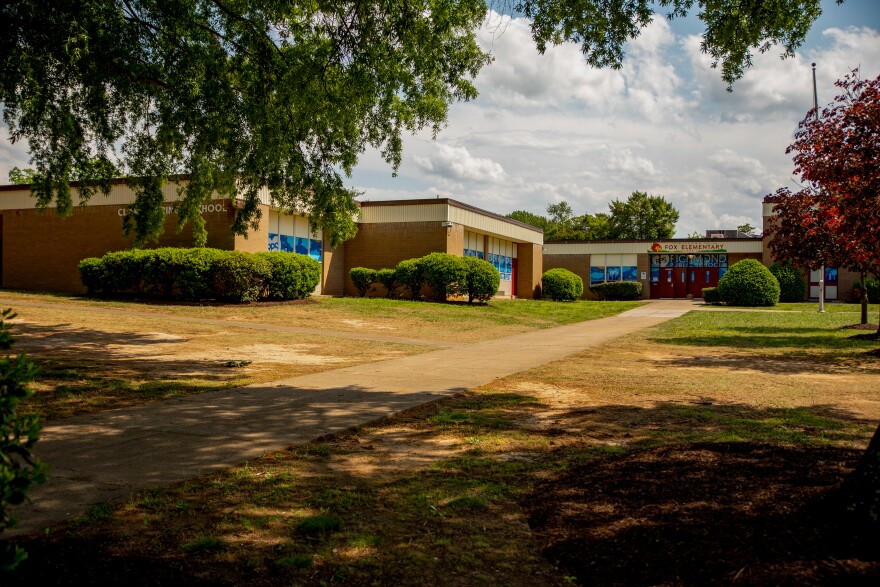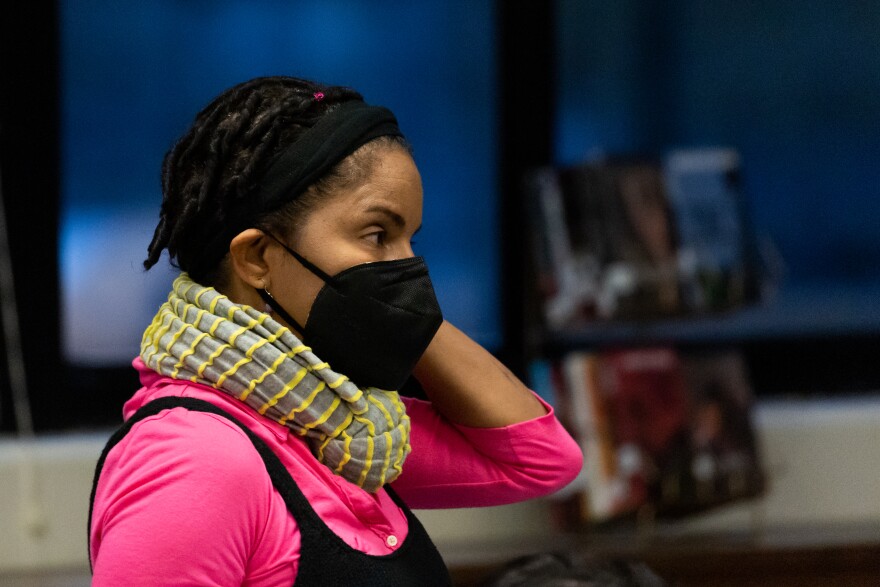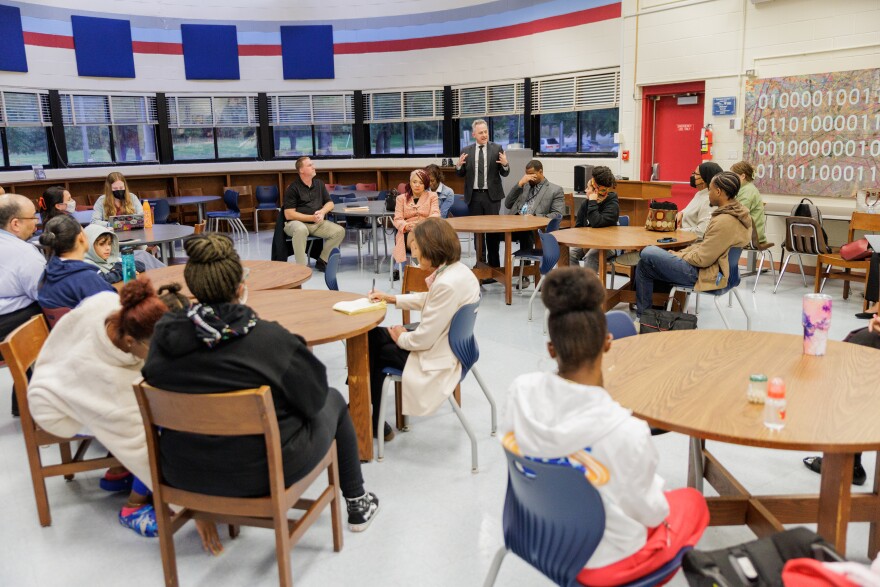The 70th anniversary of the U.S. Supreme Court's Brown v. Board of Education decision that found racial segregation in public schools unconstitutional is Friday.
One of the court cases that led to that decision began in Virginia, with calls for newer and better school facilities for Black students. This VPM News series examines the issue of school conditions — then and now — to unpack why so many Virginia schools are in disrepair today, especially in districts like Richmond Public Schools, which remains largely segregated.
Part 1 looks at the current state of RPS and the consequences of its aging facilities.
Keri Treadway was setting up her classroom library a few days before students from William Fox Elementary School began attending class at Clark Springs Elementary School. It was about three months after a three-alarm fire destroyed the 111-year-old Fox building in 2022.
Treadway is a reading interventionist for Fox students, and due to space limitations usually works in a small room located within a classroom — a quirk of the Clark Springs design. There’s no door separating the space from the main classroom, so Treadway fashioned a curtain to divide the space.

She pointed out a water stain on the wall, right behind a new row of books she was setting up. She’d already had to replace her classroom books that were destroyed in the Fox fire and hoped no new leaks would pop up when students arrived.
“Where you are standing is a water leak that I cleaned yesterday morning of just brown sludge,” Treadway said at the time. “Just crossing our fingers like, ‘All right, just don’t rain on any of the books that we just got replaced.’”
But the following week, Treadway sent VPM News photos showing that some of those new books already had brown water stains on them after mold remediation and multiple patches to the building’s roof. The district decided to replace sections of the roof that summer.
Clark Springs opened in 1967 and was one of the first Richmond schools to be air-conditioned. For the past decade, it’s served as a swing space for everything from teacher trainings to a backup building for student classes. But it’s mostly sat vacant for years, allowing mold and mildew to accumulate.
Leaks and mold are common in Richmond Public Schools. In the past couple years, there’ve been thousands of maintenance requests ranging from paint to plumbing logged for the district’s schools.
Mold was confirmed in at least half of city schools recently, which in the past has resulted in the temporary relocation of Richmond students. Exposed asbestos in Summer Hill Preschool’s auditorium led to the school’s graduation ceremony being moved this year.

Cory Adkins had just started teaching at Elkhart Middle School in 2015 when the whole school was temporarily moved to Clark Springs because a leaky pipe caused mold to grow in two classrooms.
“It was oozing down the wall, like black oozing drips of mold,” Adkins said. “It had liquefied and it would ooze down the wall.”
The district eventually decided to merge the school with another, rather than send students back to the mold-infested building. But five years later in 2020, the newly merged school also had to be closed because it was deemed “no longer fit for student or staff use.”
Now, Adkins teaches at Boushall Middle School — where staff recently called for additional mold testing after reports that the air quality has made them ill. VPM News spoke to two former Boushall staff members who stopped working there because they became sick.
Last May, Adkins went to the doctor because of coughing and sneezing and was given her first inhaler.

“I had never had to use one,” Adkins said. “Over the summer, I didn't have to use an inhaler. Nothing.”
When she returned to Boushall at the start of the 2023-24 school year, she wondered if the mold was causing her to get sick; she saw visible mold in her classroom. And then she got sick again.
“I went to Patient First and told them ‘I'm still coughing, I don't know what’s going on. I was exposed to some mold,’” Adkins said. “And they said, ‘Yeah, that could be it. Keep using the inhaler.’”
Virginia pulmonologist Dr. Amit “Bobby” Mahajan said tracking symptoms and observing how they change in varying environments and during different times of day — like Adkins did — is a legitimate way to pinpoint what might be making someone sick.
Mahajan said small amounts of mold exposure on a regular basis can cause shortness of breath and other symptoms like coughing and wheezing.
“When they come in with asthmatic symptoms or shortness of breath, especially in kids, we do ask: Is there mold in the house? Is there leaking water? Is there a space where they go, where there is an older building where they may have exposure to mold?” Mahajan said. “It’s become a relatively common question for us to ask.”
While there isn’t enough data to say what the long-term impact regular exposure to mold at home or at school can have on one’s health, Mahajan said regular exposure to certain types of mold in other environments — like on farms — have been shown to cause inflammation of the lungs and even permanent scarring.
There are currently no federal regulations or standards for acceptable levels of mold.

“From a public health standpoint, there shouldn't be mold growing anywhere in our schools,” Mahajan said.
It’s also a matter of equity.
Ben Berman, a Richmond-based nurse, said he’s seen more Black kids coming into the hospital where he works with asthma than white kids. Mold is a known asthma trigger — which Berman said can be dangerous if not handled appropriately.
“The thing about asthma is that every exacerbation comes with a risk of not being able to get it under control,” Berman said.
In order for kids to have safe learning spaces, he said, the school district needs to get to the root of the problem. That means finding what caused the mold and moisture to begin with.
“We should get rid of the mold, great. But if you don’t address the fact that the classrooms are, you know, 60% humidity — or above the 30% to 50% recommended humidity line — well, there’s just gonna be mold again one day,” Berman said.
The Environmental Protection Agency recommends indoor relative humidity be kept below 60% to prevent mold growth. Recent reports on mold and moisture in several Richmond schools found elevated moisture readings in walls, ceilings and more. For example, part of the kitchen at Albert Hill Middle School showed a higher-than-normal humidity level.
Hannah Clayman, an Albert Hill teacher, said she's seen leaking AC units at her school lead to rotting floorboards and floor tile peeling. She said three spots on the floor of her classroom have gotten patched over the years, but two of those started to peel again this school year.

“All that work has been undone because the unit keeps leaking,” Clayman told VPM News. “My concern is, what is it telling students when their own school, and their own classroom, is in such disarray? It’s hard to feel respected when a classroom is in that state.”
It’s not just mold, mildew and leaks. At least half of Richmond schools don’t have modern built-in fire suppression systems, according to data obtained by VPM News. Not having those systems can come at a cost: The Richmond Fire Department said the lack of one either caused or contributed to the severity of the Fox Elementary fire.
A VPM News investigation last year also found multiple RPS schools with repeat fire code violations stretching back to 2015.
“It takes layers, layers of disinvestment to get a school to the point that this happens,” said Becca DuVal, a Fox Elementary parent and advocate. “It takes decades of deprioritizing safety standards and putting sprinkler systems in the building for the spark to cause the fire that can’t get put out.”
Disinvestment and disinterest in the city’s school division began in earnest following desegregation orders, when white families left Richmond in droves to live in neighboring counties.
Two years after integrated busing began in 1970, a U.S. district judge wrote that full desegregation of schools would require a single regional system, combining Richmond with Henrico and Chesterfield counties. But in 1973, the U.S. Supreme Court invalidated that court’s opinion — leaving district lines between the city and counties intact.
(Having trouble seeing this graphic? View it on Flourish's website.)
Even today, despite the city of Richmond’s growing population, enrollment at RPS is declining, while places like Chesterfield County continue to grow. The ongoing flight to county schools has meant that school conditions for Richmond students remain largely separate and unequal to this day.
In the counties surrounding Richmond, approximately three out of four school buildings were either newly built or significantly renovated within the past 25 years, according to a VPM News analysis of 2021 data from the General Assembly’s Commission on School Modernization and Construction. The rates range from 70% in Henrico to 80% in Hanover. But in the city, that figure was one of four.
“We have this income inequality and nowhere is it more apparent than inside the school buildings, both in how the schools look and are maintained, but also how the children are provided for as part of our society,” DuVal said.
Dana Fox, chief operating officer for RPS, said historically, money for school improvements ends up on the chopping block year after year.
“Because that’s sort of the low hanging fruit, right?” Fox said. “So, you see those things and you see very big numbers beside them. And it’s like, ‘Well, OK, we’ll not do this this time, so that we can do all of these other things.’”
(Having trouble viewing this graphic? View it on Flourish's website.)
That’s meant some of the big upgrades, like new roofs and HVAC systems, have repeatedly been pushed to the back burner. While pandemic relief funds did help pay for some of these delayed repairs, there’s still more to do.
Last fall, Superintendent Jason Kamras presented his budget proposal to the school board. The total facilities ask (not including funds for new school construction) was over $16 million — which included requests for some roof repairs and replacements, and HVAC upgrades.
“There simply isn’t enough to go around,” Kamras said during an October school board meeting.
Despite City Council’s Monday vote to fully fund the district’s budget, the list of facilities that will receive upgrades doesn’t reflect a complete picture of renovation and reconstruction needs across the city’s schools.
“We just don't know what is going to fail and when,” Fox told VPM News. “But it is a matter of ‘when.’”
Due to limited facilities staff, RPS has hired an outside firm to conduct a facilities assessment to gauge the true cost of all upgrades needed across the district. The report is expected next month.
Part 2 looks at the history of Prince Edward County Public Schools, where the fight for equal schools in Virginia began.
Part 3 looks at potential solutions to ensure equal access to adequate school facilities.










